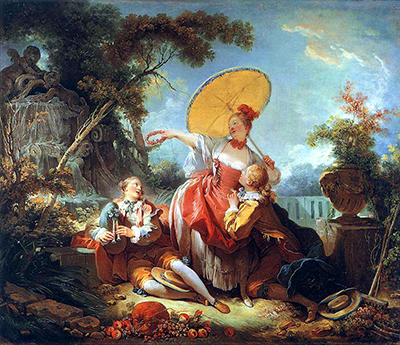 Buy Art Prints Now
Buy Art Prints Nowfrom Amazon
* As an Amazon Associate, and partner with Google Adsense and Ezoic, I earn from qualifying purchases.
Typically Fragonard, The Musical Contest features meriment and activity of a number of excitable figures, set in a beautiful backdrop with foliage and a bright sky.
This bright and enchanting paintings can be found in the Wallace Collection in London, UK and is amongst a good selection of Fragonard's original artworks. They also have a number of his miniature paintings too, which displayed another string to his bow. The Musical Contest was originally attributed to the artist's tutor, Francois Boucher, but this was eventually corrected after the piece had been purchased by the 4th Marquess of Hertford in 1842. By the time that is was passed on to its current owners in 1897, it had already been acknowledged as actually from the career of Boucher's student, Jean-Honore Fragonard.
When we browse the composition in front of us, one is immediately drawn to the female figure standing, holding aloft a bright yellow parasol. Her attire is typically glamorous, with a pink and white dress with matching accessories. She sports heavy makeup, as was the way in parts of Europe during this period, and two males stare at her with eyes of desire and respect. The gentleman on the left is playing a traditional type of musical instrument that appears to resemble a form of bag pipe and he plays along as they frolic in this picturesque garden. The outdoor environment includes a small pillar with elaborate vase perched on top, a slim tree that leans across the painting, and also further touches of detail in the far left corner with sculptural effects.
One can examine the painting's elements in order to work out how it was assigned to Fragonard instead of Boucher. His elaborate light effects and theatrical poses are said to have been the most obvious pointers to art historians, as is the artist's love for capturing complex swirls of draping cloth, be it clothing or home interior. The colours are also warm and one could almost be in the mediterranean. In the foreground we find a flurry of smaller items which are used to ensure that no part of the canvas is left blank.



